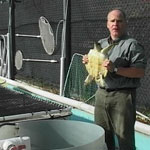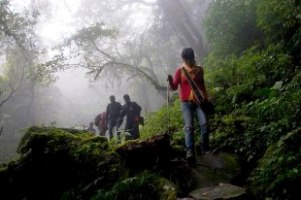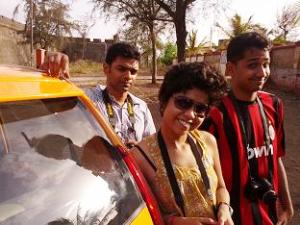SOUTH OF THE HWANG HO
Art Direction: Wong Kar Cheung (after Karchung Diyali the photographer) Cast: Tashi Chophel, Raman Shrestha, Guru T Ladakhi, Pankaj Thapa Supporting Cast: North East Writers Forum and its members.
South of The Hwang Ho is a cleverly titled film that chronicles the life of a young man Tashi, played with great conviction by technocrat turned upcoming actor, Tashi Chophel. It documents his journey from the great Himalayas down to the Kingdom of the Axom Rulers who ruled with an iron plough.
The story is set against the backdrop of two great rivers, the once turbulent but now sadly tamed Teesta, whose white waters have become wide waters, and the equally historic Tsang Po, a.k.a the Bhramaputra, a.k.a The Son of Bhrama, on whose waters the river dolphins discover tourists and noisy steamers. This mighty river is the soul of the film, though you can't see much of it as the shooting was done mostly at night.
The plot of this very imaginitive film with its equally imaginitive review is simple but poignant. Tashi plays a technocrat struggling with his alter ego as a poet. The film begins with Tashi being invited to a Writers Meet deep in the heart of Axom territory. He is accompanied on his journey by three friends who add colour and interest to the story with their individual eccentricities.
Of the three friends, the Bookworm (played with charming nonchalance by Raman Shrestha) is closest to Tashi and knows of the turmoil in the latter's personality. In fact, he even identifies with Tashi's inner conflict because he too is leading a precarious dual-life as the Frog Prince, a realm yet unknown to the informed world.
Then there is Guru (an amateur debut by theatrical personality G.T.Ladakhi), the suave debonair poet whose passion is hard whiskey and fast cars. Period. Guru's portrayal of a corporate tycoon struggling to come to terms with his anagnorisis, or sudden realisation and reversal of role from founding member to funding member raises a lump in your throat, even as the lump in his wallet gets thicker-a classic Brewster's Millions Syndrome.
The fourth member of this eclectic quad group of course, is Panks, the Joker in the pack, who wears a white hat, rides a white horse and saves the damsels, - and who incidentally is also the author of this review, which explains the white hat, horse and damsels. During the course of their arduous journey which soon turns into a quest for spirits, the four friends travel over road, rail, and river. The steamer ride on the Bhramaputra of course, is the crucial part of the film where much of the soul searching takes place, alongwith some intense whiskey searching in the dark. As the four friends battle their personal demons and temptations to slip off to Shillong, Kohima or Aizawl, the action takes you on a roller-coaster ride, building up to the heart-stopping moment when Tashi attempts to light a cigarette on the steamer. The freezing windy river and his diesel fume-induced tears make the task herculean, which is all the more ironic since Tashi Chophel does not smoke.
As a debut attempt, South of the Hwang Ho is a commendable effort that genuinely tries to give a humane perspective to a complex scenario. Cameo roles by the supporting cast lend credibility to the storyline. Watch out for Dhruba Hazarika's mute but effective cameo during the Lunch scene. The animated contortions of his eyebrows and moustache through which he reveals the secret location of the Smirnoff bottle is a feat even Jim Carey would hesitate to do. Subsequently, the relief on the face of the Manipuri Warrior after his first swig of the Smirnoff is another great shot, as is the angst-ridden expression of the Mizo Chieftain patiently waiting for the Sakura to fall. The script unfortunately does not do justice to the histrionic ability of the Arunachali superstar, as much of the plot merely requires her to be the pensive Lady from Pensam.
Halfway through the film, the four friends predictably get separated. While Guru helps Panks embark on a quest to find his long lost Rambo brother last seen in the elephant grass at Narangi, Tashi and Raman do an Indiana Jones with a distant temple. Along the way, their lissome native guide takes them to a Konyak house spelt with a K. Raman's classsic drop-jaw expression on realising its a Naga tribe and not brandy might just fetch him an Oscar. Not much happens after this as pork and rice begins to take its toll and eyelids and shoulders begin to droop The guests feel homesick and the picturesque Circuit House on the banks of the Bhramaputra begins to look desolate. The silence of the lambs and wolves is broken only by the plaintive voice of the President of the Forum calling the AGM to order. A masterful stroke that brings some semblance of order to the chaos.
While South of the Hwang Ho may not be everybody's cup of tea, it will have a certain perverse appeal to those present at the N.E.W.F. Guwahati Meet. For the rest, it would be more profitable to watch the elephant grass grow." >
SOUTH OF THE HWANG HO
Art Direction: Wong Kar Cheung (after Karchung Diyali the photographer) Cast: Tashi Chophel, Raman Shrestha, Guru T Ladakhi, Pankaj Thapa Supporting Cast: North East Writers Forum and its members.
South of The Hwang Ho is a cleverly titled film that chronicles the life of a young man Tashi, played with great conviction by technocrat turned upcoming actor, Tashi Chophel. It documents his journey from the great Himalayas down to the Kingdom of the Axom Rulers who ruled with an iron plough.
The story is set against the backdrop of two great rivers, the once turbulent but now sadly tamed Teesta, whose white waters have become wide waters, and the equally historic Tsang Po, a.k.a the Bhramaputra, a.k.a The Son of Bhrama, on whose waters the river dolphins discover tourists and noisy steamers. This mighty river is the soul of the film, though you can't see much of it as the shooting was done mostly at night.
The plot of this very imaginitive film with its equally imaginitive review is simple but poignant. Tashi plays a technocrat struggling with his alter ego as a poet. The film begins with Tashi being invited to a Writers Meet deep in the heart of Axom territory. He is accompanied on his journey by three friends who add colour and interest to the story with their individual eccentricities.
Of the three friends, the Bookworm (played with charming nonchalance by Raman Shrestha) is closest to Tashi and knows of the turmoil in the latter's personality. In fact, he even identifies with Tashi's inner conflict because he too is leading a precarious dual-life as the Frog Prince, a realm yet unknown to the informed world.
Then there is Guru (an amateur debut by theatrical personality G.T.Ladakhi), the suave debonair poet whose passion is hard whiskey and fast cars. Period. Guru's portrayal of a corporate tycoon struggling to come to terms with his anagnorisis, or sudden realisation and reversal of role from founding member to funding member raises a lump in your throat, even as the lump in his wallet gets thicker-a classic Brewster's Millions Syndrome.
The fourth member of this eclectic quad group of course, is Panks, the Joker in the pack, who wears a white hat, rides a white horse and saves the damsels, - and who incidentally is also the author of this review, which explains the white hat, horse and damsels. During the course of their arduous journey which soon turns into a quest for spirits, the four friends travel over road, rail, and river. The steamer ride on the Bhramaputra of course, is the crucial part of the film where much of the soul searching takes place, alongwith some intense whiskey searching in the dark. As the four friends battle their personal demons and temptations to slip off to Shillong, Kohima or Aizawl, the action takes you on a roller-coaster ride, building up to the heart-stopping moment when Tashi attempts to light a cigarette on the steamer. The freezing windy river and his diesel fume-induced tears make the task herculean, which is all the more ironic since Tashi Chophel does not smoke.
As a debut attempt, South of the Hwang Ho is a commendable effort that genuinely tries to give a humane perspective to a complex scenario. Cameo roles by the supporting cast lend credibility to the storyline. Watch out for Dhruba Hazarika's mute but effective cameo during the Lunch scene. The animated contortions of his eyebrows and moustache through which he reveals the secret location of the Smirnoff bottle is a feat even Jim Carey would hesitate to do. Subsequently, the relief on the face of the Manipuri Warrior after his first swig of the Smirnoff is another great shot, as is the angst-ridden expression of the Mizo Chieftain patiently waiting for the Sakura to fall. The script unfortunately does not do justice to the histrionic ability of the Arunachali superstar, as much of the plot merely requires her to be the pensive Lady from Pensam.
Halfway through the film, the four friends predictably get separated. While Guru helps Panks embark on a quest to find his long lost Rambo brother last seen in the elephant grass at Narangi, Tashi and Raman do an Indiana Jones with a distant temple. Along the way, their lissome native guide takes them to a Konyak house spelt with a K. Raman's classsic drop-jaw expression on realising its a Naga tribe and not brandy might just fetch him an Oscar. Not much happens after this as pork and rice begins to take its toll and eyelids and shoulders begin to droop The guests feel homesick and the picturesque Circuit House on the banks of the Bhramaputra begins to look desolate. The silence of the lambs and wolves is broken only by the plaintive voice of the President of the Forum calling the AGM to order. A masterful stroke that brings some semblance of order to the chaos.
While South of the Hwang Ho may not be everybody's cup of tea, it will have a certain perverse appeal to those present at the N.E.W.F. Guwahati Meet. For the rest, it would be more profitable to watch the elephant grass grow.







































